
Early adopters of agile network technology have a lot to gain in terms of competitive advantage in a fast-changing environment, says Huawei Technologies.
Speaking during a visit to South Africa this month, Wing Kin Leung, Chief Technology Officer, Solution Sales Department at Huawei Technologies, said traditional networks are not flexible and take weeks or months to reconfigure to accommodate changing business demands or new technologies. "Now, even a week is too long when change must be implemented - businesses need to reconfigure infrastructure in hours and minutes."
This need for greater agility and speed to change is driving significant growth in interest in agile network technologies, he says. Fully programmable architecture allows enterprise networks to quickly expand network functions and introduce new functions in software-defined mode, implementing agile evolution much faster than hardware-defined networks, notes Huawei.
Awareness is increasing across all industry verticals of the need for software-defined networking to underpin the agile enterprise. "In the next few years, everything will be software-defined. This will drive cost savings, efficiencies and agility. By default, all networks will also become software-defined over the next five years or so. Some bold and innovative enterprises are starting to move early - taking the risk to become early adopters - and so benefiting in terms of competitive advantage and cost savings," says Leung.
He notes that agile network and software-defined networking are particularly relevant across Africa, where cost constraints and a lack of extensive skills resources can hamper the roll-out of advanced technologies. "In a software-defined environment, fewer skills resources are necessary. There is no need to travel to the site to reconfigure the network; no engineer is sitting on-site and under-utilised," he says. In addition, African public sector and private sector organisations running hybrid physical-virtualised environments can harness software-defined networking to connect the two, allowing for a gradual migration to a fully virtualised environment, he says.
Huawei's focus on agile network architecture has seen the company engaging with growing numbers of customers across Africa on potential agile network projects. "There is significant interest, with many enterprises looking to launch pilot projects and tests. However, because these technologies are so new, there have not been many actual deployments at this stage. Making the leap will depend on each organisation's appetite for risk," he says.
Share